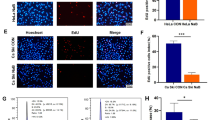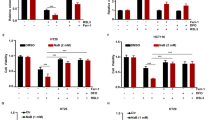Abstract
Epithelial to mesenchymal transition (EMT) is a critical step in the metastasis of epithelial cancer cells. Butyrate, which is produced from dietary fiber by colonic bacterial fermentation, has been reported to influence EMT. However, some studies have reported that butyrate promotes EMT, while others have reported an inhibitory effect. To clarify these controversial results, it is necessary to elucidate the mechanism by which butyrate can influence EMT. In this study, we examined the potential role of annexin A1 (ANXA1), which was previously reported to promote EMT in breast cancer cells, as a mediator of EMT regulation by butyrate. We found that ANXA1 mRNA and protein were expressed in highly invasive melanoma cell lines (A2058 and A375), but not in SK-MEL-5 cells, which are less invasive. We also showed that butyrate induced ANXA1 mRNA and protein expression and promoted EMT-related cell invasion in SK-MEL-5 cells. Downregulation of ANXA1 expression using specific small interfering RNAs in butyrate-treated SK-MEL-5 cells resulted in increased expression of the epithelial marker E-cadherin and decreased cell invasion. Moreover, overexpressing ANXA1 decreased the expression of the E-cadherin. Collectively, these results indicate that butyrate induces the expression of ANXA1 in human melanoma cells, which then promotes invasion through activating the EMT signaling pathway.





Similar content being viewed by others
References
Duband JL, Monier F, Delannet M, Newgreen D. Epithelium-mesenchyme transition during neural crest development. Acta Anat (Basel). 1995;154:63–78.
Polyak K, Weinberg RA. Transitions between epithelial and mesenchymal states: acquisition of malignant and stem cell traits. Nat Rev Cancer. 2009;9:265–73.
Thiery JP. Epithelial-mesenchymal transitions in tumour progression. Nat Rev Cancer. 2002;2:442–54.
Thiery JP, Acloque H, Huang RY, Nieto MA. Epithelial-mesenchymal transitions in development and disease. Cell. 2009;139:871–90.
Moustakas A, Heldin CH. Signaling networks guiding epithelial-mesenchymal transitions during embryogenesis and cancer progression. Cancer Sci. 2007;98:1512–20.
Diamond ME, Sun L, Ottaviano AJ, Joseph MJ, Munshi HG. Differential growth factor regulation of n-cadherin expression and motility in normal and malignant oral epithelium. J Cell Sci. 2008;121:2197–207.
Gumbiner BM. Cell adhesion: the molecular basis of tissue architecture and morphogenesis. Cell. 1996;84:345–57.
Berx G, Cleton-Jansen AM, Nollet F, de Leeuw WJ, van de Vijver M, Cornelisse C, van Roy F. E-cadherin is a tumour/invasion suppressor gene mutated in human lobular breast cancers. EMBO J. 1995;14:6107–15.
Birchmeier W, Behrens J. Cadherin expression in carcinomas: role in the formation of cell junctions and the prevention of invasiveness. Biochim Biophys Acta. 1994;1198:11–26.
Christofori G, Semb H. The role of the cell-adhesion molecule e-cadherin as a tumour-suppressor gene. Trends Biochem Sci. 1999;24:73–6.
Kang Y, Massague J. Epithelial-mesenchymal transitions: twist in development and metastasis. Cell. 2004;118:277–9.
Batlle E, Sancho E, Franci C, Dominguez D, Monfar M, Baulida J, Garcia De Herreros A. The transcription factor snail is a repressor of e-cadherin gene expression in epithelial tumour cells. Nat Cell Biol. 2000;2:84–9.
Canani RB, Costanzo MD, Leone L, Pedata M, Meli R, Calignano A. Potential beneficial effects of butyrate in intestinal and extraintestinal diseases. World J Gastroenterol. 2011;17:1519–28.
Heerdt BG, Houston MA, Augenlicht LH. Potentiation by specific short-chain fatty acids of differentiation and apoptosis in human colonic carcinoma cell lines. Cancer Res. 1994;54:3288–93.
Janson W, Brandner G, Siegel J. Butyrate modulates DNA-damage-induced p53 response by induction of p53-independent differentiation and apoptosis. Oncogene. 1997;15:1395–406.
Ramos MG, Rabelo FL, Duarte T, Gazzinelli RT, Alvarez-Leite JI. Butyrate induces apoptosis in murine macrophages via caspase-3, but independent of autocrine synthesis of tumor necrosis factor and nitric oxide. Braz J Med Biol Res. 2002;35:161–73.
Daly K, Shirazi-Beechey SP. Microarray analysis of butyrate regulated genes in colonic epithelial cells. DNA Cell Biol. 2006;25:49–62.
Kostyniuk CL, Dehm SM, Batten D, Bonham K. The ubiquitous and tissue specific promoters of the human src gene are repressed by inhibitors of histone deacetylases. Oncogene. 2002;21:6340–7.
Kruh J. Effects of sodium butyrate, a new pharmacological agent, on cells in culture. Mol Cell Biochem. 1982;42:65–82.
Jiang GM, Wang HS, Zhang F, Zhang KS, Liu ZC, Fang R, Wang H, Cai SH, Du J. Histone deacetylase inhibitor induction of epithelial-mesenchymal transitions via up-regulation of snail facilitates cancer progression. Biochim Biophys Acta. 2013;1833:663–71.
Serpa J, Caiado F, Carvalho T, Torre C, Goncalves LG, Casalou C, Lamosa P, Rodrigues M, Zhu Z, Lam EW, Dias S. Butyrate-rich colonic microenvironment is a relevant selection factor for metabolically adapted tumor cells. J Biol Chem. 2010;285:39211–23.
Barshishat M, Polak-Charcon S, Schwartz B. Butyrate regulates e-cadherin transcription, isoform expression and intracellular position in colon cancer cells. Br J Cancer. 2000;82:195–203.
Wang HG, Huang XD, Shen P, Li LR, Xue HT, Ji GZ. Anticancer effects of sodium butyrate on hepatocellular carcinoma cells in vitro. Int J Mol Med. 2013;31:967–74.
Guo C, Liu S, Sun MZ. Potential role of anxa1 in cancer. Future Oncol. 2013;9:1773–93.
Lim LH, Pervaiz S. Annexin 1: the new face of an old molecule. FASEB J. 2007;21:968–75.
Biaoxue R, Xiguang C, Shuanying Y. Annexin a1 in malignant tumors: current opinions and controversies. Int J Biol Markers. 2014;29:e8–20.
Solito E, de Coupade C, Parente L, Flower RJ, Russo-Marie F. Human annexin 1 is highly expressed during the differentiation of the epithelial cell line a 549: involvement of nuclear factor interleukin 6 in phorbol ester induction of annexin 1. Cell Growth Differ. 1998;9:327–36.
Solito E, de Coupade C, Parente L, Flower RJ, Russo-Marie F. Il-6 stimulates annexin 1 expression and translocation and suggests a new biological role as class ii acute phase protein. Cytokine. 1998;10:514–21.
Kang JS, Calvo BF, Maygarden SJ, Caskey LS, Mohler JL, Ornstein DK. Dysregulation of annexin i protein expression in high-grade prostatic intraepithelial neoplasia and prostate cancer. Clin Cancer Res. 2002;8:117–23.
D’Acunto CW, Fontanella B, Rodriquez M, Taddei M, Parente L, Petrella A. Histone deacetylase inhibitor fr235222 sensitizes human prostate adenocarcinoma cells to apoptosis through up-regulation of annexin a1. Cancer Lett. 2010;295:85–91.
Petrella A, D’Acunto CW, Rodriquez M, Festa M, Tosco A, Bruno I, Terracciano S, Taddei M, Paloma LG, Parente L. Effects of fr235222, a novel hdac inhibitor, in proliferation and apoptosis of human leukaemia cell lines: role of annexin a1. Eur J Cancer. 2008;44:740–9.
Lecona E, Barrasa JI, Olmo N, Llorente B, Turnay J, Lizarbe MA. Upregulation of annexin a1 expression by butyrate in human colon adenocarcinoma cells: role of p53, nf-y, and p38 mitogen-activated protein kinase. Mol Cell Biol. 2008;28:4665–74.
Mu D, Gao Z, Guo H, Zhou G, Sun B. Sodium butyrate induces growth inhibition and apoptosis in human prostate cancer du145 cells by up-regulation of the expression of annexin a1. PLoS One. 2013;8:e74922.
Graham KA, Buick RN. Sodium butyrate induces differentiation in breast cancer cell lines expressing the estrogen receptor. J Cell Physiol. 1988;136:63–71.
Weaver EM, Zamora FJ, Puplampu-Dove YA, Kiessu E, Hearne JL, Martin-Caraballo M. Regulation of t-type calcium channel expression by sodium butyrate in prostate cancer cells. Eur J Pharmacol. 2015;749:20–31.
de Graauw M, van Miltenburg MH, Schmidt MK, Pont C, Lalai R, Kartopawiro J, Pardali E, Le Devedec SE, Smit VT, van der Wal A, Van’t Veer LJ, Cleton-Jansen AM, ten Dijke P, van de Water B. Annexin a1 regulates tgf-beta signaling and promotes metastasis formation of basal-like breast cancer cells. Proc Natl Acad Sci U S A. 2010;107:6340–5.
Bizzarro V, Belvedere R, Milone MR, Pucci B, Lombardi R, Bruzzese F, Popolo A, Parente L, Budillon A, Petrella A. Annexin a1 is involved in the acquisition and maintenance of a stem cell-like/aggressive phenotype in prostate cancer cells with acquired resistance to zoledronic acid. Oncotarget. 2015;6:25076–92.
Wang Y, Lin Z, Sun L, Fan S, Huang Z, Zhang D, Yang Z, Li J, Chen W. Akt/Ezrin Tyr353/NF-kappab pathway regulates EGF-induced EMT and metastasis in tongue squamous cell carcinoma. Br J Cancer. 2014;110:695–705.
Radisky ES, Radisky DC. Matrix metalloproteinase-induced epithelial-mesenchymal transition in breast cancer. J Mammary Gland Biol Neoplasia. 2010;15:201–12.
Kang H, Ko J, Jang SW. The role of annexin a1 in expression of matrix metalloproteinase-9 and invasion of breast cancer cells. Biochem Biophys Res Commun. 2012;423:188–94.
Acknowledgments
This work was supported by the Basic Science Research Program through the National Research Foundation of Korea funded by the Ministry of Education (NRF-2013R1A1A2008633) and Asan Institute for Life Sciences, Seoul, Korea (2014-570).
Author information
Authors and Affiliations
Corresponding author
Ethics declarations
Conflicts of interest
None.
Additional information
Jimin Shin and In-Sung Song contributed equally to this work.
Rights and permissions
About this article
Cite this article
Shin, J., Song, IS., Pak, J.H. et al. Upregulation of annexin A1 expression by butyrate in human melanoma cells induces invasion by inhibiting E-cadherin expression. Tumor Biol. 37, 14577–14584 (2016). https://doi.org/10.1007/s13277-016-5306-5
Received:
Accepted:
Published:
Issue Date:
DOI: https://doi.org/10.1007/s13277-016-5306-5




